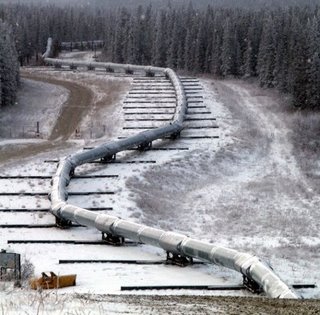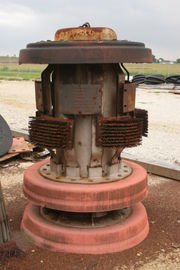Pump Jacks and Smart Pigs
Wednesday, August 09, 2006
It's surprising that Wikipedia doesn't have an entry for "smart pig". Oops! Spoke to soon. While a search for "pig" yields domesticated, guinea, and the always popular flying pig, not a single entry is spotted for anything looking like a multi-ton torpedo used to inspect and clean out oil and natural gas pipelines.
Searching for "smart pig", however, turns up a result with 11.2 percent relevance at the top of the list - "pipeline inspection gauge".
Wikipedia comes through again.
As was the case for this recent story involving pump jacks, the free online encyclopedia once again assists in learning more about a dull and largely uninteresting piece of equipment that is critical to the world of commodities. It's always a good idea to learn as much as you can about industries where your money has been put to work - even if it is dull and largely uninteresting.
~~~~~~~~~~~~~~~~~~~~~~~~~~~~Advertisement~~~~~~~~~~~~~~~~~~~~~~~~~~~
Everyone knows how to buy oil stocks, but what's the best way to invest in oil itself?
This question has recently been asked and answered at Iacono Research, resulting in a change to the Model Portfolio which now stands at +22 percent on the year.
To learn more or to sign up for a free, no-obligation two week trial, click here.
~~~~~~~~~~~~~~~~~~~~~~~~~~~~~~~~~~~~~~~~~~~~~~~~~~~~~~~~~~~~~~~~~~
Of course, the recent interest in pipeline pigs is related to the problems of a few days ago when BP discovered corrosion in sixteen miles of the Alaska Pipeline, used to transport oil from Prudhoe Bay, on the North Slope, down to southern seaports.
This oil is shipped to refineries in the lower forty-eight where it is transformed into heating oil and gasoline used to warm McMansions and power Sport Utility Vehicles. It seems BP (formerly British Petroleum, but now just BP, or, in recent days, Big Problem) neglected to send pigs down the pipeline and a terrible corrosion problem developed that will now take months to resolve.
It seems BP (formerly British Petroleum, but now just BP, or, in recent days, Big Problem) neglected to send pigs down the pipeline and a terrible corrosion problem developed that will now take months to resolve.
While the pipeline is being scrubbed and refitted, about 400,000 barrels a day of the world's most important commodity will be sitting idle on the North Slope.
This total is about half of all Alaskan oil output which contributes about one third of all crude oil used by Western refineries.
Since inventories are still historically high and extra supply is purportedly available from friendly countries such as Saudi Arabia and Mexico (where output from major oil fields has been declining in recent months), there are no immediate concerns of shortages or price spikes.
To further calm the nerves of a public now accustomed to three dollar gasoline (but not yet ready for four), the Energy Department announced that the strategic petroleum reserve is ready and willing to deliver oil into the market, if the need arises.
Early estimates are for the repair work to be completed sometime after the first of the year, so, while the news is not good, it's not really that bad. That is, unless other supply disruptions occur - then that 400,000 barrels a day would come in handy.
But, what about the pigs?
That's what's been attracting the attention of some people since the pipeline shut down.
This interview, part of yesterday's All Things Considered segment on NPR, tells of the real hero in this story. It's too bad that this is available in audio form only - surely there would be at least a hint of a smirk from reporter Nell Boyce as she delves into the details of pipeline pigs (the alliteration seems to intensify the imagery that naturally occurs when listening to a report such as this).Nell Boyce: When it comes to pipelines, there are two kinds of pigs - dumb pigs and smart pigs. Al Crouch says that dumb pigs came along first, decades ago, and to clean out the pipes.
Send in the pigs!
Al Crouch: They were often made of bales of straw, maybe with barbed wire wrapped around them and they pumped them through the line to do a cleaning job. This made a squealing sound, and that's where the name pig came from. Boyce: Crouch is an engineer at the Southwest Research Institute in San Antonio Texas. He says dumb pigs are no longer made out of straw, but companies still send the modern versions through their pipes to scrape out junk. Then there are your smart pigs. Crouch says a smart pig is a machine that has a power supply, a data storage device, and sensors that look for flaws.
Boyce: Crouch is an engineer at the Southwest Research Institute in San Antonio Texas. He says dumb pigs are no longer made out of straw, but companies still send the modern versions through their pipes to scrape out junk. Then there are your smart pigs. Crouch says a smart pig is a machine that has a power supply, a data storage device, and sensors that look for flaws.
Crouch: Since it had intelligence to it, it was called a smart pig.
Boyce: The first smart pig came along in the 1960s. Today's version are multi-million dollar machines that look like torpedoes. Some use magnetic fields, some use ultrasound. They weigh several tons and can be 15 to 20 feet long. Instead of squealing, they rumble like a freight train. Crouch says they can travel for hundreds of miles.
Crouch: What some people don't realize is the amount of data recorded by these smart pigs is enormous. Every square inch of a pipe for a hundred miles or more, and all that has to be stored onboard the pig.
Boyce: Each pig only looks for a particular kind of damage, usually corrosion or cracking. BP has been criticized for not using pigs to maintain its pipelines. The lines shutdown now haven't seen a pig since 1992, but after an oil spill earlier this year, federal regulators ordered the company to send in the pigs, and they found corrosion.
This is all very serious stuff, but at the same time it's quite amusing to listen to - surely Nell enjoyed talking about this, though there is no hint of a chuckle.
Some years ago a story of a similar nature was circulated - amusing imagery instantly coming to mind. This older story was, of course, untrue - just the clever creation of some bored engineers or marketing types at IBM. It is impossible to not think about this previous story when first hearing about smart pigs.
Urban Legends has all the details:MEMO
Mouse balls indeed.
Re: Replacement of Mouse Balls.
If a mouse fails to operate or should it perform erratically, it may need a ball replacement. Mouse balls are now available as FRU (Field Replacement Units). Because of the delicate nature of this procedure, replacement of mouse balls should only be attempted by properly trained personnel.
Before proceeding, determine the type of mouse balls by examining the underside of the mouse. Domestic balls will be larger and harder than foreign balls. Ball removal procedures differ depending upon the manufacturer of the mouse. Foreign balls can be replaced using the pop off method. Domestic balls are replaced by using the twist off method. Mouse balls are not usually static sensitive. However, excessive handling can result in sudden discharge. Upon completion of ball replacement, the mouse may be used immediately.
It is recommended that each person have a pair of spare balls for maintaining optimum customer satisfaction. Any customer missing his balls should contact the local personnel in charge of removing and replacing these necessary items.
Please keep in mind that a customer without properly working balls is an unhappy customer.











![[Most Recent Quotes from www.kitco.com]](http://kitconet.com/charts/metals/gold/t24_au_en_usoz_2.gif)
![[Most Recent Quotes from www.kitco.com]](http://kitconet.com/charts/metals/silver/t24_ag_en_usoz_2.gif)
![[Most Recent USD from www.kitco.com]](http://www.weblinks247.com/indexes/idx24_usd_en_2.gif)

2 comments:
Pump Jack manufacturers are picking up. Their main problem? No gearboxes to drive them. The gear manufacturers have moved onto new markets (wind turbines, etc.) and no longer make pump jack gearboxes.
They've almost gone the way of the buggy whip. However, in today's oil market even 3 barrels from an old well ain't half bad, so bring in a new pump jack. If and when you can find a new gearbox for one.
I remeber that mouse ball memo. I never laughed so hard in my life. That was back when PCs were still a novelty in the early 90s. Its still funny to read
Post a Comment